In the Star Trek fictional universe, shields refer to a 23rd and 24th century technology that provides starships, space stations, and entire planets with limited protection against damage. They are sometimes referred to as deflectors, deflector shields, or screens. Types of shields include navigational deflectors.

The Marathon Trilogy is a science fiction first-person shooter video game series from Bungie, originally released for the Classic Mac OS. The name of the series is derived from the giant interstellar colony ship that provides the main setting for the first game; the ship is constructed out of the Martian moon Deimos. The series is often regarded as a spiritual predecessor of Bungie's Halo series.
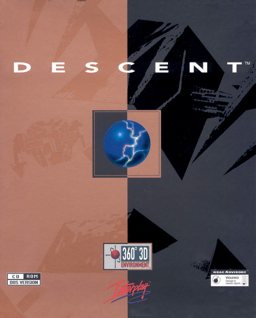
Descent is a first-person shooter (FPS) game developed by Parallax Software and released by Interplay Productions in 1995 for MS-DOS, and later for Macintosh, PlayStation, and RISC OS. It popularized a subgenre of FPS games employing six degrees of freedom and was the first FPS to feature entirely true-3D graphics. The player is cast as a mercenary hired to eliminate the threat of a mysterious extraterrestrial computer virus infecting off-world mining robots. In a series of mines throughout the Solar System, the protagonist pilots a spaceship and must locate and destroy the mine's power reactor and escape before being caught in the mine's self-destruction, defeating opposing robots along the way. Players can play online and compete in either deathmatches or cooperate to take on the robots.

Descent: FreeSpace – The Great War, known as Conflict: FreeSpace – The Great War in Europe, is a 1998 space combat simulation IBM PC compatible computer game developed by Volition, when it was split off from Parallax Software, and published by Interplay Productions. In 2001, it was ported to the Amiga platform as FreeSpace: The Great War by Hyperion Entertainment. The game places players in the role of a human pilot, who operates in several classes of starfighter and combats against opposing forces, either human or alien, in various space-faring environments, such as in orbit above a planet or within an asteroid belt. The story of the game's single player campaign focuses on a war in the 24th century between two factions, one human and the other alien, that is interrupted in its fourteenth year by the arrival of an enigmatic and militant alien race, whose genocidal advance forces the two sides into a ceasefire in order to work together to halt the threat.

SubSpace is a 2D space shooter video game created in 1995 and released in 1997 by Virgin Interactive which was a finalist for the Academy of Interactive Arts & Sciences Online Game of the Year Award in 1998. SubSpace incorporates quasi-realistic zero-friction physics into a massively multiplayer online game.
Battlefleet Gothic is a naval miniature wargame that was produced by Games Workshop from 1999 to 2013 with Andy Chambers as the primary developer. A spin-off of the science-fantasy setting of Warhammer 40,000, the game has players command fleets of large spaceships belonging to one of several spaceborne factions. Although the wargame's miniatures and rulebooks are no longer supported by Games Workshop, two video game adaptations have been made since its cancellation in 2013.
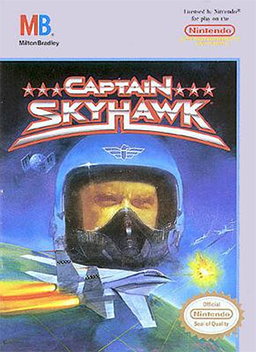
Captain Skyhawk is a scrolling shooter video game developed by Rare and published by Milton Bradley Company. The game was released in North America in June 1990 and in Europe the next year for the NES. It was also released for the PlayChoice-10 arcade machine.

Earth 2150: The Moon Project is a sequel to the real time strategy game Earth 2150. While the game is in fact a stand-alone game, many consider it an expansion pack because it does little more than provide new missions, and weapons. The story takes place alongside the original game's story. The Moon Project was released in 2000 by Strategic Simulations, Inc.
Renegade Legion is a series of science fiction games that were designed by Sam Lewis, produced by FASA, and published from 1989 to 1993. The line was then licensed to Nightshift games, a spin-off of the garage company Crunchy Frog Enterprises by Paul Arden Lidberg, which published one scenario book, a gaming aid, and three issues of a fanzine-quality periodical before reverting the license.

Nitemare 3D is a horror-themed first-person shooter released by Gray Design Associates in 1994 for MS-DOS and Windows 3.x. There are three episodes with the first episode released as shareware and ten levels in each. The full release came on two 3½" floppy disks with a guide to the game's thirty levels. According to author David P. Gray, the game is the first pixelated Windows game to use the WinG interface.
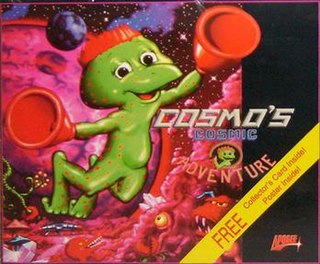
Cosmo's Cosmic Adventure: Forbidden Planet is a video game programmed by Todd Replogle and published by Apogee Software. It is a two-dimensional side-scrolling platform game. The game was released in mid March 1992 for MS-DOS compatible systems.
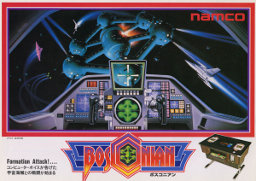
Bosconian is a scrolling multidirectional shooter arcade video game developed and released by Namco in Japan in 1981. In North America, it was manufactured and distributed by Midway Games. The goal is to earn as many points as possible by destroying enemy missiles and bases using a ship which shoots simultaneously both the front and back.

Terminal Velocity is a shooter video game originally developed by Terminal Reality and published by 3D Realms for DOS and Windows 95, and MacSoft for Mac OS. It is an arcade-style flight combat game, with simpler game controls and physics than flight simulators. It is known for its fast, high-energy action sequences, compared to flight simulators of the time.
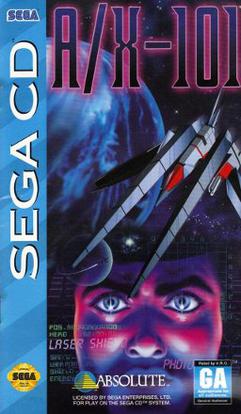
A/X-101 (エーエックス101) is a 1994 rail shooter/FMV video game for the Sega Mega-CD.

Project Sylpheed, also known as Project Sylpheed: Arc of Deception in North America, is a space simulation game for the Xbox 360 console. It was developed by SETA and published by Square Enix and Microsoft. The game is acknowledged as the spiritual successor to the Silpheed video game series, which comprised 3D rail shooters: players pilot a starfighter, shooting incoming enemies on a vertically scrolling third-person playing field. Project Sylpheed uses full 3D computer graphics and allows the player to instead pilot his or her spacecraft in any direction.

Kiloblaster is a fixed shooter video game trilogy written by Allen Pilgrim and published by Epic MegaGames in 1992 for IBM PC compatibles. Based on Namco's Galaxian from 1979, there are a few differences such as allowing greater player movement, much faster enemy movement, power-ups, enemies that take more than one hit, and allies to assist in battle.

Colony Wars: Vengeance is a space combat simulator video game developed and released by Psygnosis for the PlayStation during 1998, and sequel to the original Colony Wars, released the previous year. In this game, players complete space combat missions using preselected starships equipped with various weapons. The game features multiple paths of missions and outcomes, depending on the player's performance.
Star Wars PocketModel Trading Card Game is an out-of-print tabletop game manufactured by WizKids, Inc. that debuted in 2007, based on the Star Wars universe. The game was designed by Mike Elliott and Ethan Pasternack.
Hyper Void is a 3D shooter video game, developed and published by InFramez Technology. It was released for PlayStation 3, PlayStation 4, Xbox One and Microsoft Windows.

Commander Keen in Goodbye, Galaxy is a two-part episodic side-scrolling platform video game developed by id Software and published by Apogee Software in 1991 for DOS. It consists of the fifth and sixth episodes of the Commander Keen series, though they are numbered as the fourth and fifth, as Commander Keen in Keen Dreams is not part of the main continuity. The game follows the titular Commander Keen, an eight-year-old child genius, as he first journeys through the Shadowlands to rescue the Gnosticenes so they may ask the Oracle how the Shikadi plan to destroy the galaxy, and then through the Shikadi's Armageddon Machine to stop them. The two episodes feature Keen running, jumping, and shooting through various levels while opposed by aliens, robots, and other hazards.















